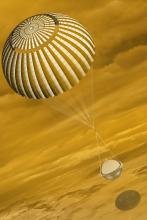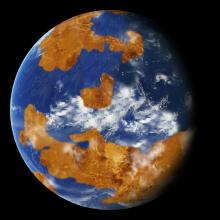Listen to today's episode of StarDate on the web the same day it airs in high-quality streaming audio without any extra ads or announcements. Choose a $8 one-month pass, or listen every day for a year for just $30.
You are here
Volcanic Venus
Venus has the most volcanic surface of any world in the solar system. Two-thirds of it is paved by volcanic plains, which hold more than 1600 major volcanoes -- and more than 85 thousand in all. But it’s not clear whether any of them is active today. There’s evidence of recent eruptions, but there hasn’t been a smoking gun -- uh, volcano -- until this year.
It’s hard to see eruptions on Venus -- or anything else, for that matter -- because clouds blanket the entire planet. The only way to see the surface is with radar, which peeks through the clouds. The best radar look to date came from the Magellan spacecraft, which orbited Venus in the 1990s.
Two researchers recently pored over thousands of pairs of Magellan images snapped months or years apart. They were looking for changes in the volcanoes -- signs of recent activity. And they found a change on the flank of Maat Mons, the planet’s biggest volcano. It’s three miles high, and the opening at its peak is 20 miles across.
An image from early 1991 showed a circular, mile-wide pit on the side of Maat Mons. Eight months later, the feature was twice as wide, had a jagged shape, and appeared to be filled with lava. Computer models found that the only reasonable explanation was a volcanic eruption -- the most direct evidence of an active volcano on Venus.
Venus is the “evening star” now. It’s shining at its brightest -- a beautiful and possibly active planet.
Script by Damond Benningfield





